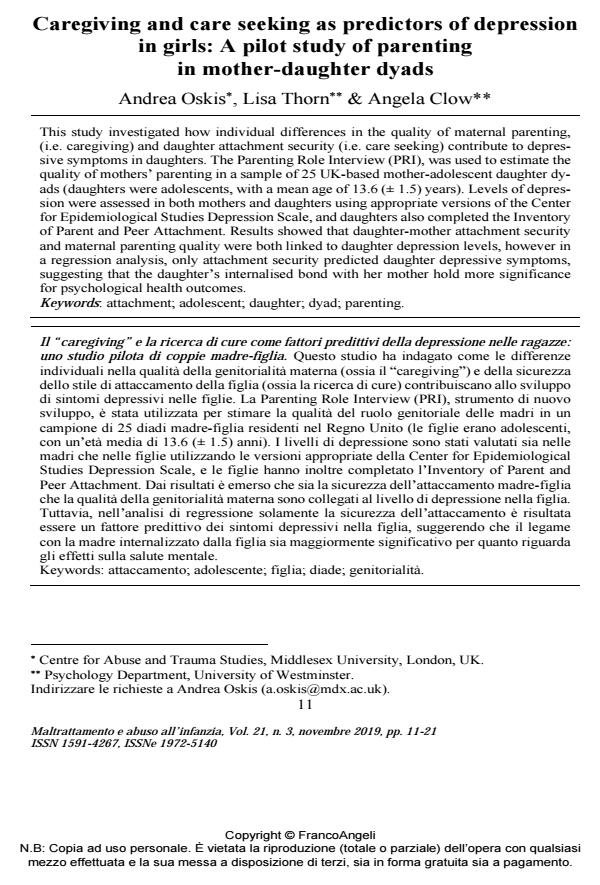Caregiving and care seeking as predictors of depression in girls: A pilot study of parenting in mother-daughter dyads
Titolo Rivista MALTRATTAMENTO E ABUSO ALL’INFANZIA
Autori/Curatori Andrea Oskis, Lisa Thorn, Angela Clow
Anno di pubblicazione 2019 Fascicolo 2019/3
Lingua Inglese Numero pagine 11 P. 11-21 Dimensione file 219 KB
DOI 10.3280/MAL2019-003002
Il DOI è il codice a barre della proprietà intellettuale: per saperne di più
clicca qui
Qui sotto puoi vedere in anteprima la prima pagina di questo articolo.
Se questo articolo ti interessa, lo puoi acquistare (e scaricare in formato pdf) seguendo le facili indicazioni per acquistare il download credit. Acquista Download Credits per scaricare questo Articolo in formato PDF

FrancoAngeli è membro della Publishers International Linking Association, Inc (PILA)associazione indipendente e non profit per facilitare (attraverso i servizi tecnologici implementati da CrossRef.org) l’accesso degli studiosi ai contenuti digitali nelle pubblicazioni professionali e scientifiche
This study investigated how individual differences in the quality of maternal parenting, (i.e. caregiving) and daughter attachment security (i.e. care seeking) contribute to depressive symptoms in daughters. The Parenting Role Interview (PRI), was used to estimate the qual-ity of mothers’ parenting in a sample of 25 UK-based mother-adolescent daughter dyads (daughters were adolescents, with a mean age of 13.6 (± 1.5) years). Levels of depression were assessed in both mothers and daughters using appropriate versions of the Center for Epidemiological Studies Depression Scale, and daughters also completed the Inventory of Parent and Peer Attachment. Results showed that daughter-mother attachment security and maternal parenting quality were both linked to daughter depression levels, however in a regression analysis, only attachment security predicted daughter depressive symptoms, suggesting that the daughter’s internalised bond with her mother hold more significance for psychological health outcomes.
Questo studio ha indagato come le differenze in-dividuali nella qualità della genitorialità materna (ossia il "caregiving") e della sicurezza del-lo stile di attaccamento della figlia (ossia la ricerca di cure) contribuiscano allo sviluppo di sintomi depressivi nelle figlie. La Parenting Role Interview (PRI), strumento di nuovo svi-luppo, è stata utilizzata per stimare la qualità del ruolo genitoriale delle madri in un campio-ne di 25 diadi madre-figlia residenti nel Regno Unito (le figlie erano adolescenti, con un’età media di 13.6 (± 1.5) anni). I livelli di depressione sono stati valutati sia nelle madri che nelle figlie utilizzando le versioni appropriate della Center for Epidemiological Studies De-pression Scale, e le figlie hanno inoltre completato l’Inventory of Parent and Peer Attach-ment. Dai risultati è emerso che sia la sicurezza dell’attaccamento madre-figlia che la qualità della genitorialità materna sono collegati al livello di depressione nella figlia. Tuttavia, nell’analisi di regressione solamente la sicurezza dell’attaccamento è risultata essere un fat-tore predittivo dei sintomi depressivi nella figlia, suggerendo che il legame con la madre internalizzato dalla figlia sia maggiormente significativo per quanto riguarda gli effetti sulla salute mentale.
Parole chiave:Attaccamento; adolescente; figlia; diade; genitorialità
Andrea Oskis, Lisa Thorn, Angela Clow, Caregiving and care seeking as predictors of depression in girls: A pilot study of parenting in mother-daughter dyads in "MALTRATTAMENTO E ABUSO ALL’INFANZIA" 3/2019, pp 11-21, DOI: 10.3280/MAL2019-003002